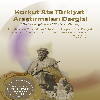Alüminyum 6013-T6 Alaşımlarının Tornalama İşlemlerinde Yüzey Pürüzlülüğünün Optimizasyonu
OPTIMIZATION OF SURFACE ROUGHNESS OF ALUMINIUM 6013-T6 ALLOY IN THE TURNING PROCESS
___
- Abasa, M., Sayda, L., Akhtara, R., Khalida, Q.S., Khanb, A.M., Pruncu, C.I., 2020, “Optimization of machining parameters of aluminum alloy 6026-T9 under MQL-assisted turning process”, Journal of Materials Research and Technology, 9(5), 10916–10940.
- Acayaba, G.M.A., Escalona, P.M., 2015, “Prediction of surface roughness in low speed turning of AISI316 austenitic stainless steel”, CIRP Journal of Manufacturing Science and Technology, 11, 62-67.
- Ajay, C.V., Vinoth V., 2021, “Optimization of process parameters in turning of aluminum alloy using response surface methodology”, Materials Today: Proceedings, 46, 9462–9468.
- Asilturk, I., Akkus, H., 2011, “Determining the effect of cutting parameters on surface roughness in hard turning using the Taguchi method”, Measurement, 44, 1697-1704.
- Bilgic, H.H., Guvenc, M.A., Cakir, M., Mistikoglu, S., 2019, “A study on prediction of surface roughness and cutting tool temperature after turning for s235jr steel“, Konya Journal of Engineering Sciences, 7, 966-974.
- Bindhushree, B.S., Arunadevi, M., Prakash, C.P.S., 2021, “Experimental investigation of process parameters for turning aluminum using ANOVA”, Materials Today: Proceedings, 46, 5060-5066.
- Davim, J.P., Figueira, L., 2007, “Machinability evaluation in hard turning of cold work tool steel (D2) with ceramic tools using statistical techniques,” Materials and Design, 28(4), 1186-1191.
- Hariharan, M.K., Anderson, A., Kumar, K. R., Senthilkumar, A., 2021, “Optimization of machining parameters in turning of LM6 high silicon aluminium alloy using aluminium titanium nitride and diamond like carbon coated carbide tool,” Materials Today: Proceedings, 45, 5853–5859.
- Jeyaprakash, N., Yang, C.H., Kumar, D.R., 2020, “Minimum cutting thickness and surface roughness achieving during micromachining of aluminium 19000 using CNC machine,” Materials Today: Proceedings, 21, 755-761.
- Kim, Y.S., Kwon, W.T., 2015, “The effect of cutting parameters for the finest surface roughness during the turning of AISI 1045 with a WC insert”, Journal of Materials Processing Technology, 29(8), 3437- 3445.
- Kumar, S.P.L., 2019, “Measurement and uncertainty analysis of surface roughness and material removal rate in micro turning operation and process parameters optimization” Measurement, 140, 538- 547.
- Lalwani, D.I., Mehta, N.K., Jain, P.K., 2008, “Experimental investigations of cutting parameters influence on cutting forces and surface roughness in finish hard turning of MDN250 steel”, Journal of Materials Processing Technology, 206(1), 167-179.
- Mia, M., Morshed, M.S., Kharshiduzzaman, M.D., Razi, M.H., Mostafa, M.R., Rahman Ahmad, S.M.S., Hafiz, M.T., Kamal, A.M., 2018, “Prediction and optimization of surface roughness in minimum quantity coolant lubrication applied turning of high hardness steel”, Measurement, 118, 43-51.
- Özlü, B., Akgün, M., Demir, H., 2019, “AA6061 Alaşımının Tornalanmasında Kesme Parametrelerinin Yüzey Pürüzlülüğü Üzerine Etkisinin Analizi ve Optimizasyonu,” Gazi Mühendislik Bilimleri Dergisi, 5(2), 151-158.
- Panthangi, R.K., Rao K.S., Babu B.S., 2021, “Optimization of surface roughness in turning of LM9 aluminum casting alloy”, Materials Today: Proceedings, 41, 1164–1168.
- Patel, V.D., Gandhi, A.H., 2019, “Analysis and modeling of surface roughness based on cutting parameters and tool nose radius in turning of AISI D2 steel using CBN tool”, Measurement,138, 34-38.
- Poulachon, G., Bandyopadhyay, B.P., Jawahir, I.S., Pheulpin, S., Seguin, E., 2004, “Wear behavior of CBN tools while turning various hardened steels”, Wear, 256(3–4), 302-310.
- Pul, M., Bican, O., 2021, “Comparison of the Effect of Alloy Type on Some Machining Properties in Turning Different Aluminum Alloys”, Mühendislik Bilimleri ve Araştırmaları Dergisi, 3 (1), 9-17.
- Pul, M., Özerkan, H.B., 2022, “The effect of cutting depth and cutting tool geometry on surface roughness and tool wear behavior in the machining of Al 6061 alloy”, Journal of the Faculty of Engineering and Architecture of Gazi University, 37(4), 2013-2024.
- Qehaja, N., Jakupi, K., Bunjaku, A., Bruçi, M., Osmani, H., 2015, “Effect of Machining Parameters and Machining Time on Surface Roughness in Dry Turning Process”, Procedia Engineering, 100, 135- 40.
- Ragab, A.E., Taha, M.A., Abbas, A.T., Al Bahkali, E.A., El-Danaf, E.A., Aly, M.F, 2017, “Effect of extrusion temperature on the surface roughness of solid state recycled aluminum alloy 6061 chips during turning operation”, Advances in Mechanical Engineering, 9(10), 1–11.
- Sarnobat, S.S., Raval, H.K., 2019, “Experimental investigation and analysis of the influence of tool edge geometry and work piece hardness on surface residual stresses, surface roughness and work- hardening in hard turning of AISI D2 steel”, Measurement, 131, 235-260.
- Selvaraj, D.P., Chandramohan, P., Mohanraj, M., 2014, “Optimization of surface roughness, cutting force and tool wear of nitrogen alloyed duplex stainless steel in a dry turning process using Taguchi Method”, Measurement, 49, 205-215.
- Sharma, A.K., Tiwari, A.K., Dixit, A.R., Singh, R.K., 2020, “Measurement of machining forces and surface roughness in turning of AISI 304 steel using alumina-MWCNT hybrid nanoparticles enriched cutting fluid”, Measurement, 150, 1-13.
- Srithar, A., Palanikumar, K., Durgaprasad, B., 2014, “Experimental Investigation and Surface roughness Analysis onHard turning of AISI D2 Steel using Coated Carbide Insert”, Procedia Engineering, 97, 72-77.
- Yağmur, S., Kaya, M.K., Şeker, U., 2021, “AA-6082 T4 Alaşımının Tornalamasında Çok Kristalli Elmas (ÇKE) Takımlara Uygulanan Talaş Kırıcı Formlarının Kesme Kuvvetleri Üzerindeki Etkilerinin Araştırılması”, Gazi Mühendislik Bilimleri Dergisi, 7(1), 51-57.
- Yayın Aralığı: Yılda 4 Sayı
- Yayıncı: Konya Teknik Üniversitesi, Mühendislik ve Doğa Bilimleri Fakültesi
Eğimli Bant Konveyörlerde Kurulu Gücün Genetik Algoritma ve Yapay Sinir Ağları Kullanılarak Tahmini
ZEMİN STABİLİZASYONUNDA BAZALT FİBER VE UÇUCU KÜL KULLANIMININ ARAŞTIRILMASI
Geometri Uydurma için En İyi Eşlenik Gradyan Yönteminin Tespit Edilmesi
Sadiye Ayşe ÇELİK, Seda ŞAHİN, Tanzer ERYILMAZ, Murat ERTUĞRUL
MEVSİMSEL DEĞİŞİMLERİN HASSAS NOKTA KONUMLAMAYA ETKİSİ
Sercan BÜLBÜL, Cevat İNAL, Burhaneddin BİLGEN
Sürdürülebilir Tedarikçi Seçimi için Aralık Tip-2 Bulanık Kural Tabanlı BWM Yaklaşımı
Müslüm ÖZTÜRK, Belkız TORĞUL, Turan PAKSOY
Mevlüt AYDIN, Mevlüt TÜRKÖZ, Yusuf Furkan YAPAN
KALP HASTALIĞI TEŞHİSİNDE YAPAY ZEKÂ YÖNTEMLERİNİN KULLANIMI VE KARŞILAŞTIRILMASI
Onur ÜNLÜ, Hüma ÜNLÜ, Yılmaz ATAY
Alüminyum 6013-T6 Alaşımlarının Tornalama İşlemlerinde Yüzey Pürüzlülüğünün Optimizasyonu
